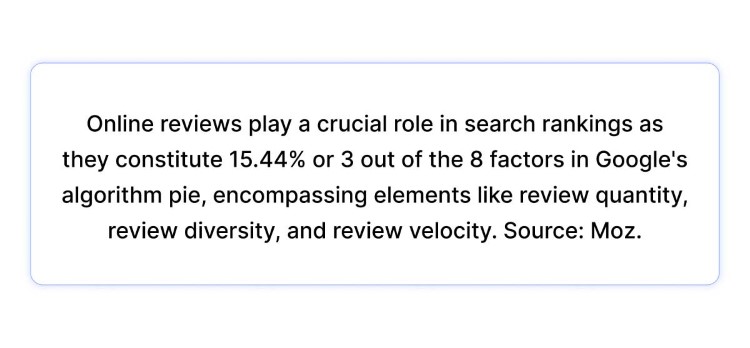How to Reply to Negative Reviews: Best Examples & Templates
- December 4, 2023
- 19 mins read
- Listen

Table of Content
In the present era, customers have numerous avenues to express their sentiments regarding your business. Ideally, you might receive a stellar five-star review on platforms such as Yelp or Google. However, there’s another side to it as well: a dissatisfied customer may criticize your company on the internet. Negative customer feedback can be a tough pill to swallow for any business. It affects a company’s reputation, dampens team morale, and chances are high that companies will also lose customers.
Even if your business is performing exceptionally well, it’s inevitable that negative reviews will arise at some point. Acquiring the ability to effectively respond to negative reviews is an important skill for every business owner and customer service manager. Not dealing with bad reviews properly can make people think negatively about your brand and harm your ability to build a successful business.
In this read, we will explore some useful tips on how to personally respond to bad reviews. Plus, we will also provide actionable response templates that can help you tackle negative customer reviews with professionalism and empathy.

Reacting to bad customer reviews
Why Should You Respond to Negative Customer Feedback?
Responding to negative reviews is like turning a challenge into a triumph for businesses. It’s not just about tackling criticism; it’s a chance to showcase your commitment to customer happiness and demonstrate that your brand is resilient and responsive. By engaging with dissatisfied customers openly and honestly, you not only diffuse potential negativity but also turn the spotlight on your brand’s dedication to customer satisfaction.
Here’s why responding to negative customer reviews is important!
-
Protects Your Brand Reputation
In today’s digital world, a single negative review can spread like fire. Negative reviews have the potential to harm a company’s brand reputation by allowing customers to broadcast their unfavorable experiences to a wider audience. This can result in decreased customer loyalty and brand reputation.
When you get back with a well-crafted response chances are high that it can mitigate damage, show that you care for your customers, and even turn critics into advocates.
-
It Shows that You Care for Your Customers
A study by Review Tracker revealed that a significant 94% of consumers opt not to support a business when confronted with negative reviews. On the flip side, if your business has a lot of negative reviews chances are high that your potential customers opt to seek products or services elsewhere.
By responding to native customer feedback, you send a clear message: customers are important for you and their feedback matters a lot. Your response shows that you are listening and will take necessary actions for offering better services. This simple gesture can make customers feel appreciated and respected, even when things don’t go as expected.
-
Attract New Customers
Many potential customers often judge a brand based on how it handles customer complaints. A respectful, solution-focused response reassures them that their concerns also will be taken seriously. Such a gesture helps to build trust.
In today’s hyper-connected world, where reviews and testimonials play a pivotal role in decision-making, a single response can make or break your first impression with future customers.
-
Impact on Search Rankings
Negative reviews can influence the search engine ranking of a business. Search engines, such as Google, take into account both the quality and quantity of online reviews as significant factors in their ranking algorithms. If a business has a higher number of negative reviews compared to positive ones, its search engine ranking may decline. This can pose challenges for potential customers seeking to find the business online. So, it’s important to respond to those negative customer feedback and try to sort things out ASAP.
-
Provides Valuable Insights
Negative customer feedback helps you to dig deeper to understand what went wrong and uncover insights that might otherwise go unnoticed. When you reply to a negative customer review and take the conversation offline you will get to know the underlying issues in detail and can fix those in a better way.

Importance of online reviews
What to Do When You Get a Negative Review?
Getting hit with a negative review can feel like a curveball, but don’t panic! Take a moment, read the review carefully, and resist the urge to hit back. Instead, put on your empathy hat and respond with genuine concern. Apologize sincerely, address the issue head-on, and if possible, toss in a sprinkle of solution. Let your customers know you’re on it! And here’s the secret sauce: invite them to chat offline to sort things out privately. Remember, it’s not just about fixing one problem: it’s about showing the world your dedication to making things right!
So how can you respond to such negative reviews? We will discuss it in the next section with expert tips and strategies.
How to Respond to Negative Reviews: Tips & Examples
Responding to negative feedback from dissatisfied customers is an essential practice now —it brings too many benefits for your business to ignore. Turning a blind eye only amplifies the impact of negative comments. Having a well-defined strategy for addressing unfavorable reviews simplifies the process, offering guidance on navigating what can be a challenging situation.
It personalizes the approach enabling your team to consistently connect with customers, even when facing a high volume of reviews. Here are some personalized best practices that you can follow as examples of negative or 1-star customer reviews.
1. Don’t Take It Personally
Although the reviewer may have expressed their sentiments with apparent emotion, it is advisable to regulate your own emotions and uphold a professional demeanor. This helps prevent the situation from escalating into a heated argument, as engaging in disputes is not at all good for your brand.
What does it mean? Just don’t take it personally. Chances are, the reviewer perceives the business as an impersonal entity, overlooking the real man behind the scenes. Resist getting weighed down by the negative feedback; instead, view it as a chance to glean insights, attentively listen, and enhance your relationship with clients.
Pro Tips:
- Pause for a bit and compose your thoughts before crafting a response.
- Avoid giving in to emotional reactions when faced with negative comments.
- See negative reviews as chances for growth and consider them as valuable feedback for your business.
- Express empathy in your response by recognizing the customer’s concerns and showing understanding of their point of view.
- If negative reviews are impacting you on a personal level, reach out to colleagues or supervisors for support.
2. Prompt Responses Matter
We exist in a world where instant gratification is the norm, with features like same-day delivery and round-the-clock assistance. Customers want swift responses from your company’s support agents, regardless of when the interaction was initiated. To align with both the reviewer’s expectations and those of potential customers perusing your reviews, it’s important to respond to comments promptly.
Live chat tools like REVE Chat can be a great help here. It is an omnichannel AI powered customer service platform that allows companies to offer instant assistance on websites, mobile apps and other social media channels like Facebook, Viber, Instagram, Telegram and WhatsApp. Through REVE Chat you can personally engage with customers and offer assistance much before they even ask for it.
Pro Tips:
- Activate notifications for reviews across platforms to stay updated on new feedback.
- Establish specific response time objectives such as addressing reviews within 1-2 hours.
- Recognize and give priority to negative reviews demanding urgent attention.
- Explore using automation tools, such as live chat or chatbots, for timely alerts and efficient real-time assistance.
- Employ a review management system to streamline and organize your responses, enhancing overall efficiency.
- Regularly review and revise your response procedures to maintain their effectiveness and alignment with your business objectives.
3. Customize Your Reply
Generic copy-and-paste responses won’t suffice. If you aim to win back dissatisfied customers and convince potential ones that your response is genuine, following a strategy or template is fine—just ensure that you customize your reply to the specific review.
Begin by incorporating the customer’s name to create a more personalized message for him. Acknowledge the specific details they mentioned in their review to demonstrate that you’ve carefully read and considered their feedback. Communicate any actionable changes that you are going to take to avoid such mistakes in the near future. Personalization adds credibility, which is crucial for recovering from negative feedback.
Pro Tips:
- Start your response by using the customer’s name for a more personalized touch.
- Point out the specific concerns raised in the review to demonstrate a thorough understanding of their feedback.
- Create a response that is specifically crafted for the individual review.
- Infuse a friendly and conversational tone into your reply.
- Consistently use the customer’s name throughout your response to uphold a personal connection.
- Transparently acknowledge any mistakes or shortcomings and communicate openly about the actions being taken to address the concerns.
- Invite the customer to contact you privately for a more detailed discussion if necessary.
4. Express Gratitude and Apologize
Expressing gratitude for the customer’s thoughtful review goes a long way. Acknowledge their effort in bringing faults to your attention, turning it into an opportunity for improvement. Extend sincere apologies for their less-than-ideal experience. Demonstrating respect and politeness in response to any unfavorable comments showcases a high level of professionalism on your part.
Not everyone is ready to write words like “My apology.” The fact that your business is willing to express gratitude for negative reviews and offer apologies for any inconvenience or dissatisfaction speaks volumes about its character.
Pro Tips:
- Initiate your response by showing appreciation for the customer’s feedback.
- Avoid making excuses or assigning blame. Take ownership of any shortcomings, even if the issue was not entirely within your control.
- Present your apology in a positive light. Concentrate on the actions being taken to rectify the issue rather than emphasizing the negative aspects.
- Customize your apology to align with the specific details outlined in the review.
- Wrap up your response in a positive tone. Express gratitude once more for the customer’s feedback and convey your optimism about the chance to rebuild his trust.
5. Avoid Arguments
Don’t make things worse by arguing or getting defensive in your replies. Given that a high standard of customer service is a significant purchasing factor in today’s consumer landscape. Avoid letting negative things slide online, where it could potentially form the initial impression for prospective customers.
Show respect for the customer and the experience he has shared. Don’t shy away from admitting fault; it can significantly boost your online reputation compared to ignoring issues. Focus your response on solutions rather than debating the problem itself. Make an effort to rectify the situation. This is your best chance at resolving the issue; arguing about their feedback won’t improve anything.
Pro Tips:
- Refrain from reacting hastily in the midst of strong emotions.
- Avoid using defensive language or confrontational tones; instead, concentrate on discovering common ground for addressing the issue.
- Acknowledge positive aspects of the customer’s experience or any favorable feedback they shared, if relevant.
- If a review gets too argumentative, it’s okay to step back. Keep in mind that going on may not help, and it’s fine to focus on keeping a positive online image.
6. Provide Direct Communication Options for Customers
Transitioning the discussion to your company’s messaging platform or a phone call is often the best course of action for certain interactions. This not only reflects positively on your commitment to resolving issues and assisting dissatisfied customers but also enables you to collect additional personal info—such as contacts or order details—that shouldn’t be shared publicly.
A key element in converting dissatisfied customers into loyal ones is the act of genuinely listening to their concerns. Even if a mistake occurs, taking proactive steps to rectify the situation and make amends can transform a customer into a devoted fan. The importance of active and attentive listening should not be neglected.
Pro Tips:
- Encourage customers to use direct messages for private and detailed discussions.
- If suitable, share a contact phone number to indicate your readiness to resolve issues through direct communication.
- If your business offers a live chat feature, prompt customers to utilize it for immediate assistance.
- Ensure customers that you are accessible and eager to promptly address their concerns through direct communication channels.
- Verify that the communication channels provided are accessible and monitored, ensuring timely responses to customer inquiries.
7. Stick to the Problem
When you are responding to a negative review, it’s important to stay focused on the issue at hand. Avoid changing the subject, as this can make the customer feel like his concerns are not important. Instead, address the exact problem the customer has raised. Trying to shift the conversation away from the main complaint will likely frustrate the customer even more, and that’s the last thing you want.
Pro Tips:
- Address the specific problem raised in the review without sidestepping it.
- Refer to specifics in their review, such as product issues or service failures, to show you’re listening and care about their feedback.
- Focus on empathy, not explaining why the issue occurred.
- Suggest a clear solution to the problem, such as a refund, replacement, or additional support.
8. Ask for a Last Chance
An apology alone won’t fix anything if there’s no real effort and change from your side. It’s important to follow up your apology with action. Ask the customers how you can make things right for them. Offering to continue the conversation privately, whether through a phone call or live chat, can make a significant difference. Sometimes, a personal touch like speaking directly to the customer can help resolve the issue in a more meaningful way. Taking the conversation offline also allows you to address concerns without the constraints of public forums.
Pro Tips:
- Acknowledge the issue and then immediately suggest steps you’ll take to resolve it.
- If appropriate, offer to call them directly.
- Reference specific details from their review to show you are genuinely listening to their feedback
- Let the customer know exactly what steps you’re taking to ensure the same issue doesn’t happen again.
- Once changes are made, ask for feedback from the same customer to ensure the solution has met their expectations.
Industry Specific Negative Review Examples and Templates
Regardless of your industry, getting negative reviews will be a part of doing business. Sometimes you may feel bad but trust me this is an opportunity to understand how your business is performing, what your customers are thinking about your product offerings and to work more for further betterment.
To help you out, here’s a list of sample negative reviews and response templates to adeptly manage challenging scenarios from different industries. Whether you opt for ready-to-use templates or choose to tailor your responses to fit the unique circumstances of each negative review, these templates will provide a helpful starting point.
1. Negative Review Response Template for eCommerce
Negative Feedback Example:
“The product I received was completely damaged. On top of that, your return process is frustrating and very slow.”
Response Template:
“We’re truly sorry to hear about your experience. Receiving a damaged product is disappointing, and a frustrating return process only adds to the inconvenience. We sincerely apologize for the trouble caused. Please contact us directly at [contact information] with your order details, and we’ll resolve this ASAP. Thank you for contacting us.”
2. Negative Review Response Template for Banks
Negative Feedback Example:
“My loan application has been stuck in review for weeks, and I haven’t received any updates. This is becoming a challenge for me.”
Response Template:
“We’re sorry to hear this. We understand how important this is and regret any inconvenience this has caused. Please contact us at [contact information] with your application details, and we’ll prioritize getting you an update. Thank you for your patience.”
3. Negative Review Response Template for Insurance Companies
Negative Feedback Example:
“My premium rises every year without any explanation. I’m thinking about switching to another company.”
Response Template:
“We understand your concerns about premium increases and apologize for any frustration this has caused. Premium adjustments are influenced by various factors, including market conditions and claims history. Let us review your policy and discuss options to ensure you’re getting the best value. Please contact us at [contact information]. We value your loyalty and are always here to help.”
4. Negative Review Response Template for Telecom Companies
Negative Feedback Example:
“My internet has been down for two days. I have got in touch with your customer service department a couple of times but no one has provided a clear update or resolution.”
Response Template:
“We sincerely apologize for the extended service disruption and lack of communication from our team. We understand how essential internet service is and are committed to resolving this issue quickly. Please contact us at [contact information], and we’ll prioritize getting your service back up and running. Thank you for your patience.”
5. Negative Review Response Template for Financial Companies
Negative Feedback Example:
” I was charged a fee that I wasn’t told about when I opened my account. This feels deceptive.”
Response Template:
“We apologize for any confusion regarding fees associated with your account. Transparency is important to us, and we regret that this wasn’t clearly communicated. Please reach out to us at [contact information], and we’ll review your account to provide clarity and resolve any issues. Thank you for letting us know.”
6. Negative Review Response Template for Travel Companies
Negative Feedback Example:
“The tour was poorly organized, and the guide was a bit rude. Also, we missed out on key attractions due to scheduling issues.”
Response Template:
“We’re sorry to hear that your experience with our tour did not meet expectations. Your feedback is important to us. Please contact us at [contact information] to discuss this further, and we’ll do our best to make it right.”
7. Negative Review Response Template for Restaurants
Negative Review Example:
” We visited your restaurant a week ago and had a disappointing experience. The food served to us was cold, and the service was extremely slow.”
Response Template:
“Thank you for sharing your experience with us. We’re sorry to hear that your visit did not meet expectations. Delays and cold food are not the standards we aim for, and we sincerely apologize for the inconvenience. We’d love to make it up to you—please contact us directly at [contact information] so we can address this personally and ensure a better experience.”
8. Negative Review Response Template for Technology/Software Companies
Negative Feedback Example:
“Their app crashes constantly, and customer support is unresponsive. I expected much better from a paid service.”
Response Template:
“Thank you for bringing this to our attention. We sincerely apologize for the technical issues and any delays in our support responses. Please email us at [contact information], and we’ll prioritize your case to ensure a smoother experience moving forward.”
9. Negative Review Response Template for Healthcare/Hospitals
Negative Feedback Example:
“I had to wait over three hours to see a doctor, even though I had an appointment. This is unacceptable!”
Response Template:
“We’re truly sorry for the extended wait time you experienced during your visit. We understand how valuable your time is and regret any inconvenience caused. Please contact us at [contact information] so we can learn more about your experience and work towards improving our scheduling process. Thank you for bringing this to our attention.”
10. Negative Review Response Template for Educational Institutions
Negative Feedback Example:
” I enrolled for a French course at this institution, but I was really disappointed with my experience. The course material was outdated, and the instructor was not very clear in explaining the concepts.”
Response Template:
“We’re sorry to hear that. At [Institution Name], we aim to provide high-quality education and engaging sessions. Please contact us at [contact information] to share more details, and we’ll work with the teaching team to address this concern and ensure improvements.”
11. Negative Review Response Template for Beauty Salons
Negative Feedback Example:
“The tools didn’t seem clean, and the salon wasn’t as tidy as I expected. Very disappointing.”
Response Template:
“We sincerely apologize for your concerns about cleanliness during your visit. Maintaining a hygienic and welcoming environment is essential to us. Please contact us at [contact information] with more details, and we’ll ensure immediate action is taken to address this issue. Thank you for bringing it to our attention.”
12. Negative Review Response Template for Real Estate
Negative Feedback Example:
“The property I bought had hidden issues that were not disclosed, and now I am left with costly repairs.”
Response Template:
“We apologize for such issues with the property and completely understand how frustrating this must be. Please contact us at [contact information] so we can review the situation and work to address your concerns. Thank you for bringing this to our attention.”
Wrapping Up!
Let’s face it. Receiving negative reviews is disheartening.
But HOLD ON! As long as you respond promptly, tactfully, and follow up, you can turn negative reviews into a positive opportunity for your business. If you can transform the author of the bad review into a devoted customer, you will gain powerful social proof in favor of your company.
It’s essential to highlight that relying solely on online reviews for social proof isn’t your only option. You have various alternatives to consider. Leveraging social proof to enhance conversions can be achieved through great customer assistance.
Turn to REVE Chat for assistance. This omnichannel customer engagement platform enables you to provide instant support on your website, mobile app, and various social media platforms. It also helps you to collect real-time reviews and reply to customer complaints on various platforms instantly. REVE Chatbot automates several business operations, including customer service, allowing you to extend services even outside regular business hours.
Keen to try it out? Sign Up for the 14-day FREE TRIAL today!
Frequently Asked Questions
When we encounter negative feedback, our initial response tends to be defensive or in denial. Yet, responding in this manner to negative reviews can harm your brand.
A more constructive approach to negative feedback involves adopting a receptive and open mindset. Rather than reacting defensively, strive to comprehend the customer’s perspective and the specific concerns they are highlighting.
Customers write negative reviews primarily to express dissatisfaction, whether from poor service, defective products, or unmet expectations. The companies should take these feedback very seriously and respond as soon as possible to fix those.
When you receive a negative review, it’s important to respond professionally. Acknowledge the customer’s concerns, apologize, express empathy, and if possible, offer a solution. In case the issue requires further investigation, invite the customer to discuss it privately through email or phone to resolve it personally.
Addressing a 1-star review without any text can be challenging since there are no specific details and reasons to respond to. However, you can still handle it with professionalism and empathy by acknowledging it, asking for more details and showing a willingness to resolve it.
No, you should not delete negative reviews as it can damage trust. Instead, address the reviews professionally. Only remove reviews that are offensive, fraudulent, or violate platform policies.
The impact of a single 1-star review on your overall rating can be quite significant, and the number of 5-star reviews needed to counterbalance it varies based on your existing rating and total review count. Typically, a single 1-star review can drag down your average, so it usually requires multiple 5-star reviews to bring things back into balance. On average, around 4 to 5 5-star reviews might be needed to neutralize the effect of one 1-star review.



